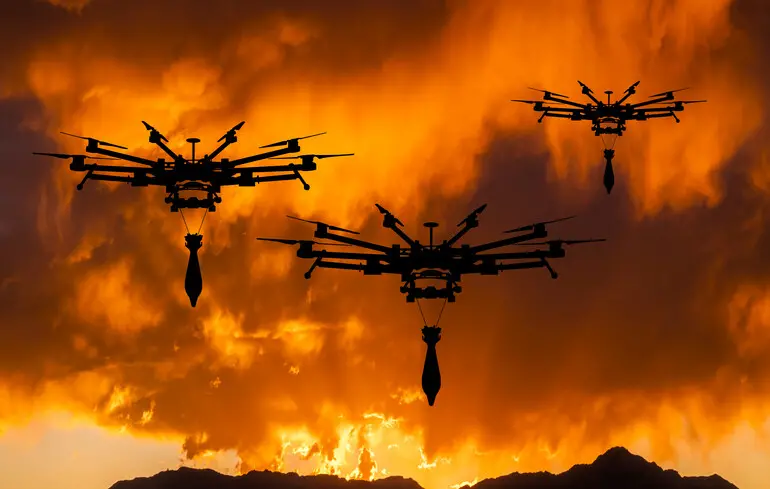Unmanned Deadlock: Why Ukrainian Drones Do Not Change the Course of the War

An analysis of the effectiveness of long-range unmanned deep strike attacks (based on open sources and insights) shows that up to 80 percent of launched drones (there is still a large percentage of failed launches) do not reach their targets due to enemy countermeasures, such as air defense, electronic warfare, imperfect design of the drones themselves, poor mission planning by crews, tactical errors of use and strategic mistakes by the military staff, whose officers are very poorly versed in the capabilities of unmanned vehicles.
Our drones have undoubtedly achieved great results: oil depots in Russia burn, ammunition depots explode, combat aircraft are destroyed at airfields and logistics are disrupted. However, this almost never happens in the Moscow region, where the air defense and electronic warfare system is the most powerful, so we have to evaluate the actions and draw conclusions based on what few raids have been carried out on Moscow. After all, if the Russian military command has concentrated half of its air defense forces to protect the capital, this target is very important for Putin, for the strength of the Russian government and for the Kremlin's position in the negotiation process. After all, if Ukrainian long-range combat drones were bombing Moscow every night, the war would be completely different today.
In total, the Ukrainian Defense Forces have launched just over ten missions aimed at Moscow (according to open sources), which does not correlate with the almost daily (nightly) attacks on Kyiv. Why is this happening? Let's try to figure it out by analyzing open-source data on the most famous raids on Moscow.
On the night of May 3, 2023, two unmanned aerial vehicles attacked the Kremlin. Seeing as no one has claimed responsibility for this ever since, here we can only speak of it as the most effective of all attacks on Moscow.
On May 30, 2023, Moscow was attacked en masse by attack drones for the first time. Some of the drones were shot down as they approached the Russian capital, but at least three UAVs caused damage to residential buildings in Moscow itself. Evil tongues say that this raid was authorized by Budanov in response to the drone and missile attack on the building complex of the Main Intelligence Directorate (MID) of the Ministry of Defense in Kyiv on May 29, 2023.
In the summer of 2023, Ukrainian combat drones attacked the Moscow City business center in central Moscow three times: on July 30, August 1 and August 23. This did not lead to any serious consequences, but it can be argued that it was at this time that Putin ordered a significant reinforcement of the air defense in the Moscow region, even if to the detriment of air defense in other regions of Russia.
As a result, serious attacks on Moscow stopped for more than a year (the media do not report on the non-serious ones). It was no longer possible to fly to Moscow “only by GPS”: the enemy had concentrated the largest number of electronic warfare stations from the Ukrainian border to the Moscow region, and the tightly deployed Pantsir missile systems, even those brought from Arctic garrisons, left no chance for drones, even the vaunted and very expensive Liutyi (“Ferocious”).
On the night of September 1, 2024, more than 158 Ukrainian drones (according to the enemy) attacked the Moscow region. Only one (!) Liutyi reached Moscow itself — the Moscow oil refinery. If we take the average price of a drone to be $100,000 (according to some sources, up to $175,000), this action cost Ukraine $158,000 x $100,000 = $15,800,000. Evil tongues (insiders) say that 400 drones were launched across Moscow that night, and only 12 of them reached the Moscow region.
The most massive (and most publicized) is the joint airborne unmanned operation of various structures of the Defense Forces carried out on March 11, 2025. According to enemy reports, Russians spotted 337 drones and presumably about 400 were launched. The Moscow region was reached by 71 (detected by the enemy) drones of the Beaver and Liutyi types, each worth more than $100,000. As a result, a residential building and warehouses in the Moscow region were damaged. Not a single vehicle made it to Moscow. The minimum cost of the action was 400 x 100,000 = $40 million. There was a lot of publicity, but the effectiveness was virtually zero.
Shortly after the “most massive” attack, a small combat operation of the Ukrainian Defense Forces went almost unnoticed, during which 10 or 12 unmanned aerial vehicles flew to the Moscow region. Five of them reached Moscow itself and two exploded in the immediate vicinity of the Kremlin (according to social media and media reports).
The enemy reported on social media that these were “homemade drones costing no more than $5,000,” which makes it easy to calculate the effectiveness: the cost of the action is 12 x 5000 = $60,000, and the share of drones reaching Moscow is 60 percent. The percentage of flights to the center of Moscow is 24 percent. An incredible result!
In other words, after analyzing two campaigns in Moscow — one that cost more than $40 million and the other that cost only $60,000 — we can say that in the first case, having launched 400 drones, we got zero results, and in the second, having launched 12 drones, we got results ranging from 24 to 60 percent. Why is this happening? Why are tens or even hundreds of millions of taxpayers' dollars literally thrown away during such a terrible and grueling war?
There are several reasons.
Imperfection of drone designs. While the enemy has (according to its own data) about 450 engineers, designers and programmers working on improving one model of the Geran drone, each “garage cooperative” of several dozen amateurs builds their own Wunderwaffe, which cannot overcome Russian air defense and electronic warfare on the way to Moscow.
And here, as we can see, the price of the drone itself does not play a decisive role. A device assembled from expensive components can lose to a cheap one if the latter's tactical techniques are superior.
Fragmentation of unmanned forces that raid Russian regions. Today, attack drones exist in the structure of the MID, Security Service of Ukraine, Armed Forces of Ukraine and at least four other security agencies, where they are a source of pride, publicity and a way to win the favor of the Supreme Commander-in-Chief (CinC).
Imagine what would happen if all the incoming F-16s were divided between Maliuk, Budanov, Syrskyi and other commanders, instead of being given to Ukraine’s Air Forces. It would be a mess, wouldn't it? But we have reconnaissance and counterintelligence units, Armed Forces units, Special Forces and others engaged in making long-range combat drones... Such dispersion of forces and unhealthy competition certainly does not lead to success.
Ineffective tactics of using long-range attack drones. The large number of different types of imperfect drones makes it impossible to develop and hone effective tactics for their use and to improve their equipment. The mere fact that the drones took off and did not kill any personnel at the start is considered a success (long-range drones of imperfect design have a bad habit of periodically exploding during launches).
Terrible strategy for using long-range strike drones. Drones are a new industry. There are at least seven (!) drone commands at the departmental level and one central, the General Staff. Besides, there are also the Presidential Office and the Headquarters of the Supreme CinC, which periodically give “valuable” instructions on the use of combat drones. This inevitably leads to disorder and reduces the effectiveness of the campaign. Because there is simply no such number of experienced drone commanders in our country (neither in Russia, nor in Germany, nor even in the United States) who would be enough for all the numerous headquarters.
Corruption. After it turned out (but it was known much earlier) that long-range drones are potentially effective weapons and we need them in incredible quantities, it became a source of corruption.
Judge for yourself: while we need only 300 reconnaissance drones of the airplane type, costing about $40–50,000, we need at least 100 Ukrainian combat “Shaheds” per day. That's a lot of money.
At the same time, reconnaissance drones are reusable, it is easy to check what is inside them, how they fly, how they perform their tasks, how effective they are, whereas attack drones are disposable. That's why it's important for the dealers that they just fly over the front line or the border, after which they can easily attribute their loss to enemy air defense or electronic warfare. And no one will ever count the price per unit, whether it was $5,000 or $150,000.
Of course, strange as it sounds, not everyone steals from us. But the corruption risks in such a “gold mine,” when there is no centralized unified management and control, are very high. After all, everything related to deep strikes — prices, effectiveness, strategy (or lack thereof), tactics of use — is highly classified.
The only way out of this corruption and technological deadlock is to eliminate fragmentation, join forces and create a single command for long-range drone bombing with the broadest possible powers. And yes — this is very important — such a command should be headed by a seasoned professional, not an appointed ceremonial figurehead.
And this is not about Colonel Vadym Sukharevskyi and the Unmanned Systems Forces (USF): the USF is but a minor one-seventh of what can be called the deep strike “market.”
There is no unified command, no development strategy, no tactics of use and no unified state policy in the drone industry in general.
If Ukrainian drones bombed Moscow every night, we would have a much stronger position on the world stage today, and the beaten and humiliated Putin would be weaker, both in Russia and abroad. No one respects a dictator who cannot even defend his lair, his Kremlin.
Please select it with the mouse and press Ctrl+Enter or Submit a bug

















 Login with Google
Login with Google